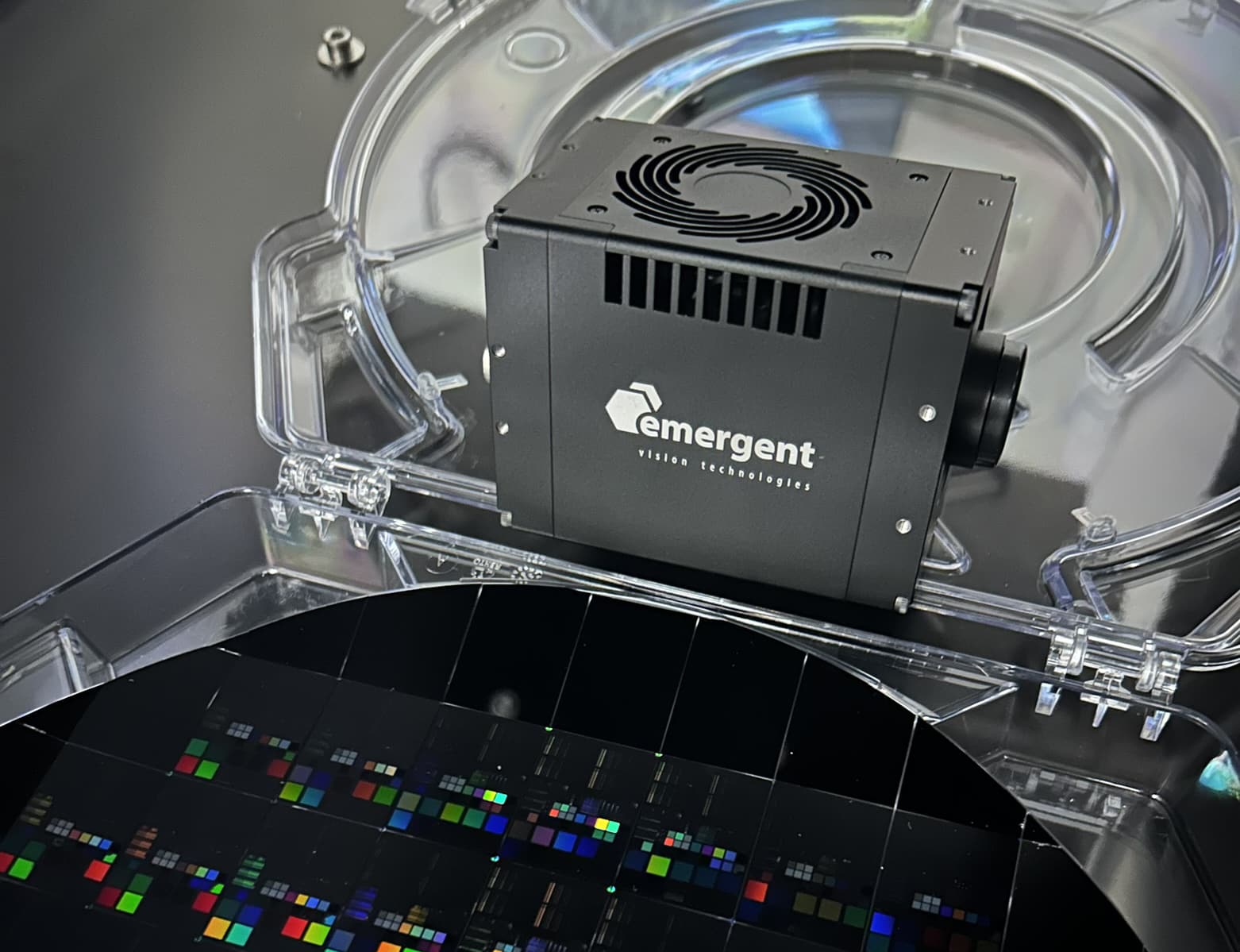White Paper: 10GigE and 25GigE FAQs
FAQ’s
10GigE (a.k.a. 10 Gigabit Ethernet) is the successor to 1GigE (1 Gigabit Ethernet) which is the leading interface for machine vision applications. 10GigE, as the successor, provides all the same benefits of 1GigE but with a ten-fold increase in data- rate which leads to a ten-fold increase in frame rate. 25GigE goes a step further with a twenty-five-fold increase in data-rate and frame rate.
10GigE and 25GigE, as with 1GigE, are part of an industry standard which has been around for years and is managed/produced by the IEEE 802.3 working group. The standard is used in applications such as telecom, data communications, industrial, military, etc, and now we leverage the benefits of this globally accepted cross-industry technology for machine vision applications.
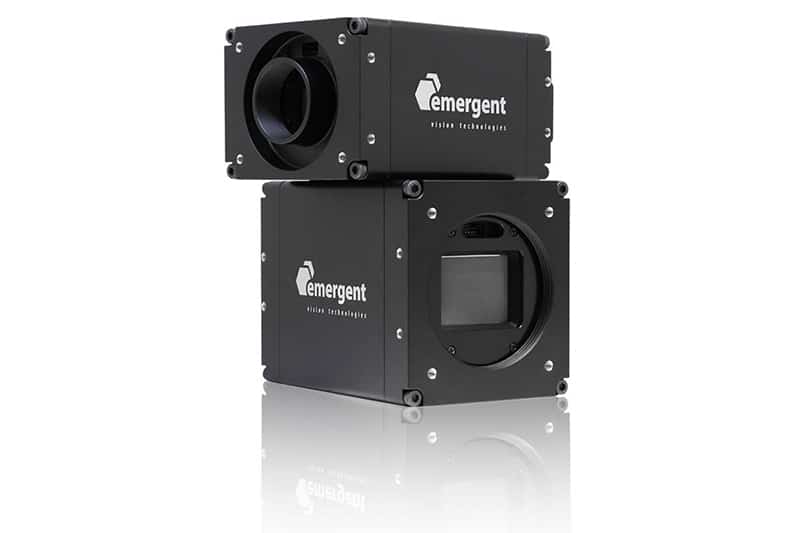
Yes. GigEVision (the machine vision specific interface standard) regardless of its version supports 10GigE and 25GigE cameras. The later versions add some additional 10GigE specific elements which are not critical for the operation of Emergent cameras with various GigE Vision compliant software such as NI Labview, MVTec Halcon, Norpix StreamPix, Matrox MIL, Cognex VisionPro, etc.
The maximum bandwidth available for 10GigE is 10Gbps or 1,250 Mbytes/s and for 25GigE is 3,125Mbytes/s which is the industry’s fastest single link solution.
Absolutely, both 10GigE and 25GigE are considered the new SDI since Broadcast is quickly abandoning the legacy SDI interface for Ethernet based technologies. The streaming technology for Broadcast is SMPTE 2110 and Emergent cameras are a firmware upgrade away from supporting this technology for a seamless drop into a variety of Broadcast applications. SMPTE 2110 and RCP features will be added to Emergent cameras this year.
One of the most important benefits of using a strong standard such as GigE is the wide variety of components made available by multiple companies across multiple industries. Cabling options are no exception. The two main connector options for 10GigE are SFP+ and RJ45. RJ45 is a good option for shorter cable lengths since the power consumption of such a solution can add an additional 2W of power for running the full 100m which becomes a bit of a problem as we attempt to make cameras more compact. SFP+ is the most flexible option and is conscious of keeping power consumption to a minimum. For 25GigE, the standard defines SFP28 which is fully compatible with SFP+ in multi-rate switches or other equipment.
Using the SFP+ or SFP28 interface provides primarily three options which cover the cable length requirements of all applications. The first and least expensive option is Direct Attach which is a copper based passive solution and the cable lengths for these single piece cables range from 1m to 10m. The second option utilizes SFP+ or SFP28 multi-mode fiber modules/transceivers and LC-LC multi-mode fiber cables and the cable lengths for this three-piece cable range from 1m to 300m. The third option utilizes SFP+ or SFP28 single-mode fiber modules/transceivers and LC-LC single-mode fiber cables and the cable lengths for this three-piece cable range from 1m to tens of Kilometers.
The price range for these cabling options is very low since they are used across multiple industries in massive volumes unlike for some interface technologies which use cabling options specific to machine vision.

As mentioned, components for 10GigE and 25GigE machine vision applications are used across multiple industries which allows suppliers of such technologies to deal in volumes which in turn leads to lower cost- far more-so than machine vision specific interfaces and technologies who also find themselves scrambling around trying to find components to fit the application and when available then sometimes only one or a few providers are in play which allows them to dictate the price.
Further, the adoption rate of 10GigE has already surpassed predictions from almost a decade ago when Emergent launched its first 10GigE camera models. The interface now largely dominates data center and many other applications which in turn drives prices down. 25GigE is already very well established in many industries and was a standard very heavily driven by major industries related to telecom and data-centers.
These industries did not like 40GigE and desperately wanted 25GigE to fill a void in speed ranges for Ethernet but also to have a link speed to build higher speed interfaces such as 100GigE which is simply QSFP28 (quad 25GigE).
For the cameras, the price scales with performance. All Emergent camera pricing is most often better in price-performance comparisons with Machine Vision specific interfaces such as USB, CoaXPress(CXP), or CameraLink.
Power consumption of 10GigE Emergent cameras is around 7W which is as good or better than a camera of equal performance. At 25GigE, the power rises only to about 9W which is again as good or better for a camera of equal performance. This power consumption is far less driven by the interface and more-so driven by the FPGA processing required at such high data rates.
This is a very important topic since a few camera vendors have just now released 10GigE cameras 10 years after Emergent first launched its 10GigE camera series and they are learning a valuable lesson in performance.
When our cameras were first launched 10 years ago, Emergent realized the need for performance receiver technology at the computer and partnered with Myricom to create a fully CPU offloaded solution called MVA or Machine Vision Accelerator.
More recently, Emergent has also partnered with Mellanox to implement the same technology with Mellanox’ VMA or Mellanox’ Messaging Accelerator to allow support for 25GigE NICs and higher.
The benefits of such technology are:
- Maximizing camera count per PC
- Extremely low CPU utilization (2% single CPU core overhead for a 9Gbps video stream)
- Minimized System Memory bandwidth
- Extremely low latency (please see section below for test results)
- Extremely low jitter (please see section below for test results)
The first bullet is mainly the result of the 2nd and 3rd points. The software employs DMA or Direct Memory Access from the NIC (network interface card) to system memory without packet headers and thus placing complete video frames into contiguous memory locations without the need for CPU or system memory interaction due to data copies or other NDIS kernel bypass activities.
Limitations that have been reported back to us from our customers about competing 10G camera technology includes trouble with dropped packets and frames with even one camera. In addition, some of these competitors have openly confirmed to customers that they have not tested more than 2 cameras per PC. Many of our customers depend on our reliability to run as many 8-14 cameras per PC. Emergent Vision Technologies has provided dependable, fully functional multicamera systems to our customers for several years now. In addition, more cameras per computer substantially reduces overall system cost.
All of this applies equally to Emergent 25GigE cameras and Mellanox’ 25GigE dual port NIC takes over for these higher speed applications and for roughly the same price as a Myricom 10GigE dual port NIC.
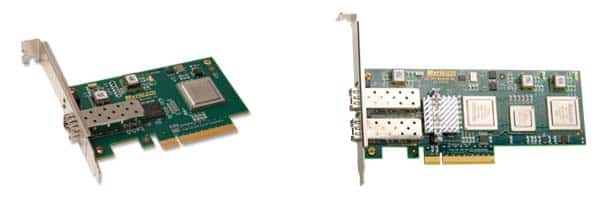
- Ultra high data/frame rates
- Many accessory and cabling options to cover any length
- Camera network support and accurate multi-camera synchronization methods including PTP support
- Multicast video technology
- Low CPU overhead, low latency, low jitter using Myricom’s MVA and Mellanox’ VMA
- Highest camera count per PC performance
- Very competitive cost/performance
- Industry acceptance due to IEEE and AIA standardization
Utilizing Myricom’s MVA or Mellanox VMA we obtain the results below. With a theoretical transfer time of 3595us at 10Gbps line rate (2044x1088x2bytesx8bits / 10Gbps = 3595us) we achieve the following results on Windows and Linux based on a 3000 frame sample size. Latency is naturally a function of image size so just by virtue of running at 10G rates compared to 1G rates already provides a ten-fold improvement in latency. We then shift our attention to the added (or overhead) contribution of latency which we can see by subtracting the theoretical from the actual which is seen as the mean of the two histograms below such that on Windows 3752us-3595us = 157us added latency which is extremely good for Windows. For Linux we get even better 3665us-3595us = 70us added latency.
The standard deviation and thus jitter is also seen to be extremely good at about +/-30us and +/-15us respectively for Windows and Linux. Using MVA or VMA, 10GigE bests 1GigE and many other interface technologies that rely on cooperation by the operating system- even if said technologies include the most currently advanced driver technologies. Thus, for top performance, use Emergent cameras with Myricom MVA or Mellanox VMA.
For 25GigE, the latency improves by a factor of 2.5 which means about 1438us for the example provided above.

Emergent 10GigE and 25GigE cameras, coupled with Myricom’s MVA or Mellanox’ VMA, equals or out-performs other interfaces in every technical category and its price performance is the best. With VMA or MVA, all the shortcomings associated with 1GigE w.r.t. CPU utilization, latency and jitter are obliterated. Industry acceptance is excellent as well.
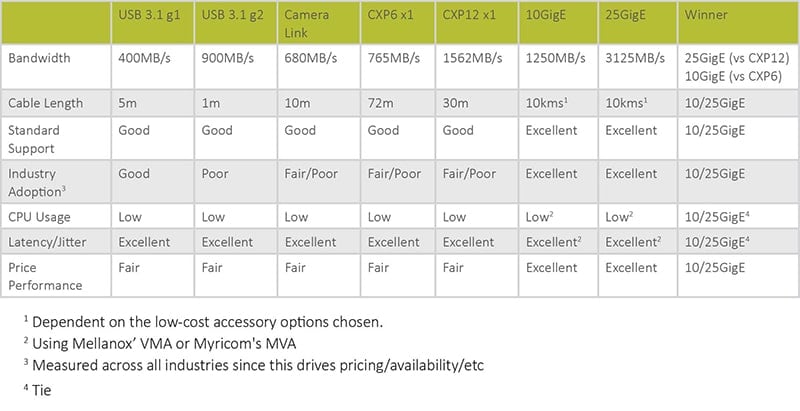
A few comments are necessary to justify the conclusions here and the reader is left to agree or validate further as we always suggest for those making purchases especially when reading information from other sales-driven sources and that includes magazine articles which are often directly or indirectly funded by proponents of a given interface technology.
Bandwidth:
Here, the closest competitor is CXP. Naturally, 10GigE can be a competitor to both CXP6 and CXP12 in which case 10GigE has higher bandwidth to CXP6 but only slightly lagging behind CXP12. If the customer needs higher speeds than 10GigE, then 25GigE would be used which doubles the bandwidth of CXP12.
We logically offer 10GigE and 25GigE to span the variety of resolution and frame rate needs of our customers.
We would be remiss to not address the concept of multiple link capabilities of CXP. Naturally, speeds can be increased as multiple cables are added. The main factor that one will run into with this is a substantially added cost due to higher grade camera, cable and frame grabber products and this is especially true when long cable runs are desired where expensive fiber adapters are needed and with each link needing a separate fiber adapter CXP channel. One thing to note here is that sensors need time to catch up as there are very few worthy sensors at higher speeds than 25GigE so for now put away your expensive CXP12 x4 links and when the sensors are ready, which is still years away, then we will have a low cost single link solution.
Cable Length:
Here, the closest competitor is CXP. Low cost commodity SFP+ and SFP28 transceivers create a virtually limitless link length. In comparison, CXP6 and CXP12 will achieve 72m and 30m respectively but can go further with the afore mentioned expensive fiber adapters. It is important to distinguish between SFP+/SFP28 transceivers and CXP or CameraLink fiber adapters. Transceivers are low cost commodity product which slots directly in the camera and NIC while the fiber adapters are expensive bulky external pieces of hardware (often the same size as the camera itself or even bigger) produced by very few suppliers and these sit somewhere in-between the camera CXP or CameraLink cable(s) and the fiber link which, interestingly enough, employs the same SFP+ transceivers that Emergent cameras employ directly in the camera. And, naturally, you need one fiber adapter at each end of the link since the grabber will typically have the same interface as the camera.
Standard Support:
This is an easy win for Ethernet technologies with the backing of the IEEE and having AIA support with GigEVision accentuates this. Any Ethernet technology that exists can also apply to its use in Machine Vision or Broadcast applications. Topping the list are: general networking, PTP, Multicast, SMPTE 2110 and many other pre-defined protocols.
Industry Adoption:
Here we consider the adoption of the interface technology over all industries and not just over the relatively small single industry of Machine Vision. In this light, there is no question what the preferred interface is and thus what will drive product availability, pricing, and technology advances.
CPU Usage/Latency/Jitter:
Emergent’s partnerships with Mellanox and Myricom have helped to equal the performance of the top frame grabbers in the industry but at a significant price discount.
Price Performance:
This is what it often all comes down to and we invite customers to get their complete system quotes from our competitors and absolutely make sure to perform the technical due diligence and then compare all results before committing to any solution. This goes as much for competitors pushing their expensive CXP wares as for competitors supplying 10GigE or other Ethernet based cameras as it is not just about the technology but it is also about the quality of the implementation and support.
In conclusion, when getting quotes for comparison, make sure at minimum that 10GigE is being compared to either CXP6 x1/x2 or CXP12 x1 and that 25GigE is being compared to either CXP6 x4 or CXP12 x2.
Additionally, one should understand how many camera channels per PCIe slot you are getting in your frame grabber in comparison to our NICs. We offer up to 2x 25GigE port cards which is the equivalent of a CXP6 x8 card or CXP12 x4 assuming that the CXP card has independent camera channel support.
Lastly, understand your cabling options especially cable length restrictions as these can dictate a significantly added cost if CXP fiber converters are needed.
Emergent’s solution supports Windows 7/8/10 and Ubuntu, RedHat, and CentOS Linux with both our eCapture viewer software and our eSDK.
Yes. Our cameras follow the GigE Vision standard and are thus compatible regardless of Ethernet speed.
Highest performance is available when Emergent drivers are used and coupled with Mellanox or Myricom NICs and 3rd party softwares typically provide the ability to use our low-level driver for frame capture through GenTL technology or other proprietary means.
Cables, switches, network interface cards- to name a few.
Many companies have long been on board with industrial modules and chassis blades with SFP+ interfaces which lends itself very nicely to a scalable and distributed processing architecture.
The chart below shows very clearly 10GigE and 25GigE adoption for various applications.
Note how 1GigE is creeping out while both 10GigE and 25GigE are taking an undeniable stronghold of the marketplace. Note also that the bulk of connector/ cable technologies are SFP+(for 10G) and SFP28(for 25G) and not 10GBaseT/RJ45 or other copper-based Ethernet technologies as the main players consider this legacy and refuse to develop new products of this nature. This is due to higher power consumption of BaseT technology but also the lack of incompatibility of BaseT with multi-rate switches or other technologies where SFP+ and SFP28 can co-exist.
We note that for short runs of < 10m, SFP+/SFP28 compatible copper based direct attach cabling can be used which are very lower power.
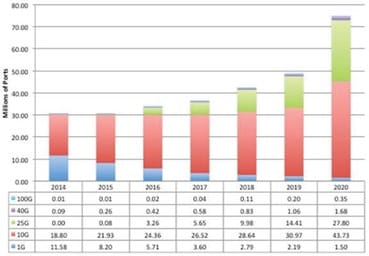
Server data rate deployment (Source: Discerning Analytics, LLC)
PTP methods are commonly used with Emergent cameras. The EVT_PTP eSDK example can be used to kick off your development. With switches and appropriate grandmaster configuration, one can synchronize to sub-microsecond accuracies. Switches have substantially dropped in price over the past 10 years so one should not be afraid of the cost implications. That said, PTP does not require switches and hardware grandmasters if synchronization accuracy requirement is not in the 10s of micro-second range.
In addition, Emergent offers the standard GPIO accessory options to allow the user to trigger the cameras via external hardware triggering through some user provided hardware signal and do so to sub-microsecond accuracies.
Please see also for switchless synchronization: https://emergentvisiontec.com/resources/
The EVT_Mcast/EVT_Mcast_Master and EVT_Mcast/EVT_Mcast_Slave eSDK examples can be used to kick off your development.
In general, the video from one camera can be sent through a low-cost switch to multiple receivers. The receivers would typically do the following in these type of applications: they might just receive and display the video for monitoring purposes, they might process the data to allow for a distributed processing architecture, they might save image files to RAID storage, or perhaps they may do all of these things with suitable server performance.
One computer is typically the multicast master so you would run a form of EVT_ Mcast_Master there. This application controls the camera(s) and optionally receives the video data. One or many other computers would run a form of EVT_Mcast_Slave which would receive and process the video data.
Generally, any GigEVision compatible software should work with Emergent cameras by virtue of Emergent cameras being certified as GigEVision compliant by the AIA. We have tested with a many 3rd party softwares such as NI Vision Acquisition Toolbox, MVTec Halcon, Norpix StreamPix 6, Matrox MIL, Cognex VisionPro, etc. Emergent also offers free software with a camera purchase: eCapture is our free viewer software, and eSDK is our C++ SDK for easy high-performance application development.
Standard computers that have an available PCIe x8 or x16 slot will support the Mellanox and Myricom NICs in a variety of operating systems. Very simple and inexpensive mini-desktops by Asus have an available x16 PCIe slot and can be used for development. Compact expansion chassis such as Sonnettech Echo Express SE III can be used to hold the NICs and link back to a laptop via Thunderbolt 3.
High camera count applications would typically employ Supermicro or Asus systems with many available PCIe slots.
The final system would only depend on how much image processing is required and at what data/frame rate. For processor intensive applications, GPU/Video cards by NVidia running CUDA or 3rd party FPGA cards can be employed. Since the data arriving from the Mellanox or Myricom NICs comes with extremely low overhead this allows the system to easily transfer this data to a GPU for further processing.
In conclusion, with Emergent camera and host technology, we give you the best chance for success for your application.
10 years ago, Emergent premiered the world’s first Area Scan 10GigE cameras and since then has been considered the pioneer of ultra-high-speed Ethernet cameras. More recently, Emergent launched the world’s first 25GigE Area Scan cameras and the world’s first 10GigE and 25GigE Line Scan cameras. This has been recognized by Vision Systems Magazine with Gold and Platinum Innovators Awards as well as by the NABSHOW with 2019 Product of the Year award in the Camera category.
Now, 10 years later, competing camera companies are seeing the need for high speed Ethernet camera technology. Some have attempted to launch their own 10GigE cameras, but they have struggled with performance issues thus bringing many of their customers to us. Our many years of experience with the technology is unmatched in the industry. Our products are very mature and reliable which saves customer time and money integrating this high-speed technology.
Emergent provides all the fundamental accessories required to develop your system and application.
We provide all SFP+ cabling options you may need such as Direct Attach cables (ie. SFPDA-3M), Optical transceivers (ie. XCVR_SR = multi-mode or “short reach”, XCVR_LR = single-mode or “long reach”) and LC-LC fiber cable for both multi-mode and single- mode applications. Single mode fiber is generally for long distance applications beyond 300m so please contact Emergent with your requirements).
We provide single and dual port 10G and 25G Network Interface cards from our partners Mellanox and Myricom Inc.
Lastly, we provide GPIO and power supply options to complete your integration needs.
We are a one-stop shop for your 10GigE and 25GigE machine vision application needs.
Emergent has frame rate calculator tools available on our website: https://emergentvisiontec.com/resources/
Network switches play a bigger role in robust installations that some would think and the cost of such devices in multi-camera setups is considered low and dropping due to cross-industry use. There are three major reasons why switches may be employed:
PTP distribution
Here, a single high accuracy PTP grandmaster clock can be easily distributed to all devices which are connected through the switch.
Camera/Device Multiplexing
10x 10GigE cameras like the HR-12000-SC could be multiplexed onto a single 100GigE link back to a server holding a single-port 100GigE NIC. This is necessary for some systems which use servers with limited PCIe slots which hold the NICs. Consider that in a 10 camera per PC application that this would require 5x dual port 10GigE NICs which increases server cost due to higher slot count in addition to the added cost of the 5x Dual 10G NICs vs 1x Single 100G NIC. And note that a 100G NIC from Emergent will also come with the same performance advantages as stated above which is best in class.
Redundancy
With the multiplexing points in mind, consider that if a single server with a 100G NIC becomes unavailable that a quick switchover to a similar redundant server will allow for virtually 0 down time. Consider also that performing redundancy with fewer higher speed links like 1x 100G vs 10x 10G requires much fewer switch ports.



